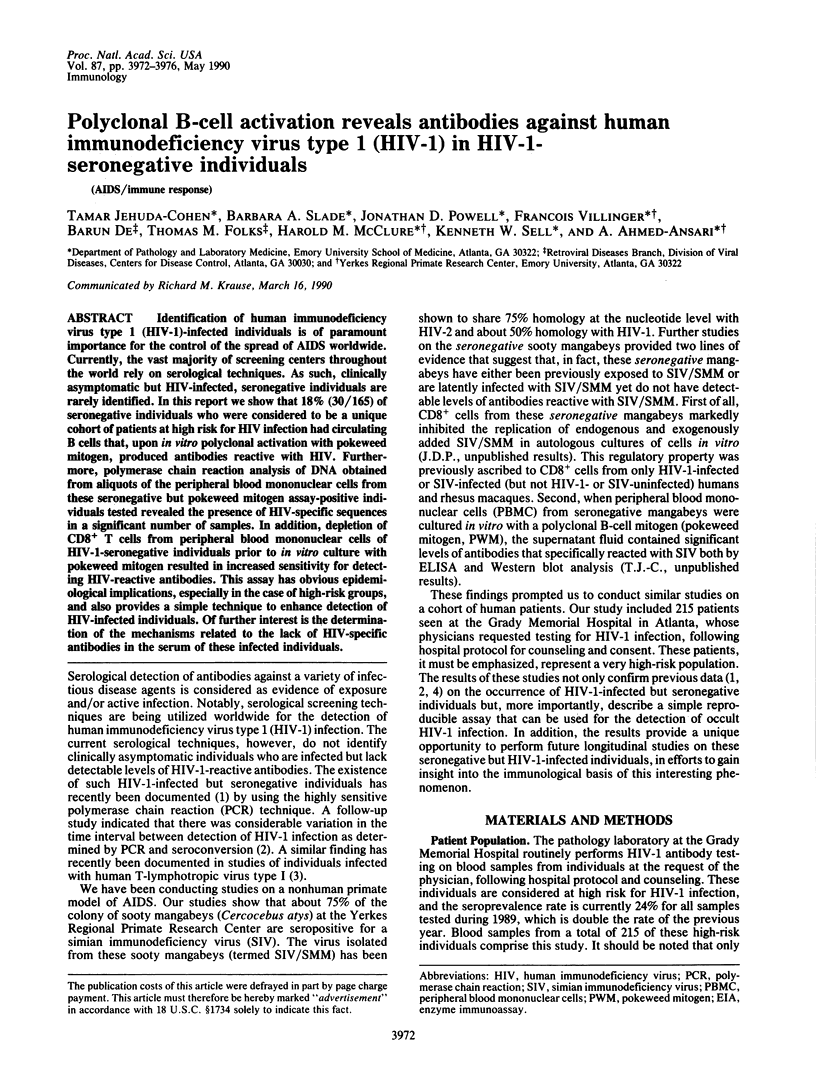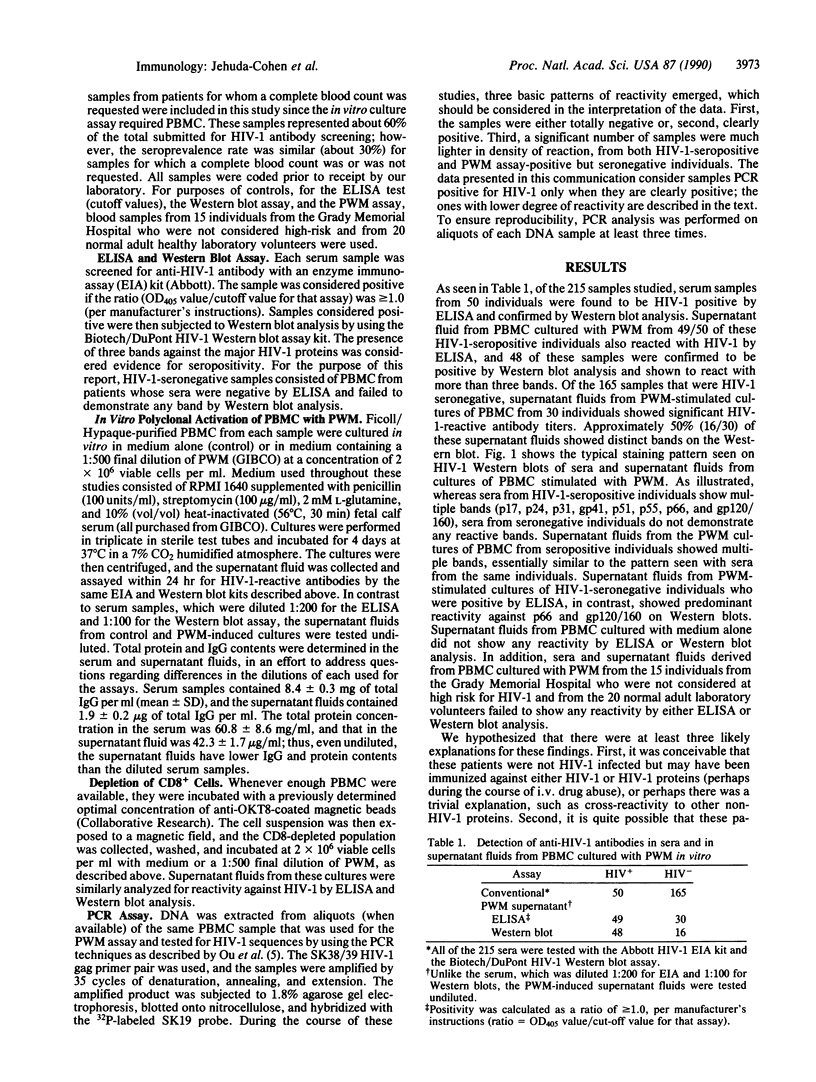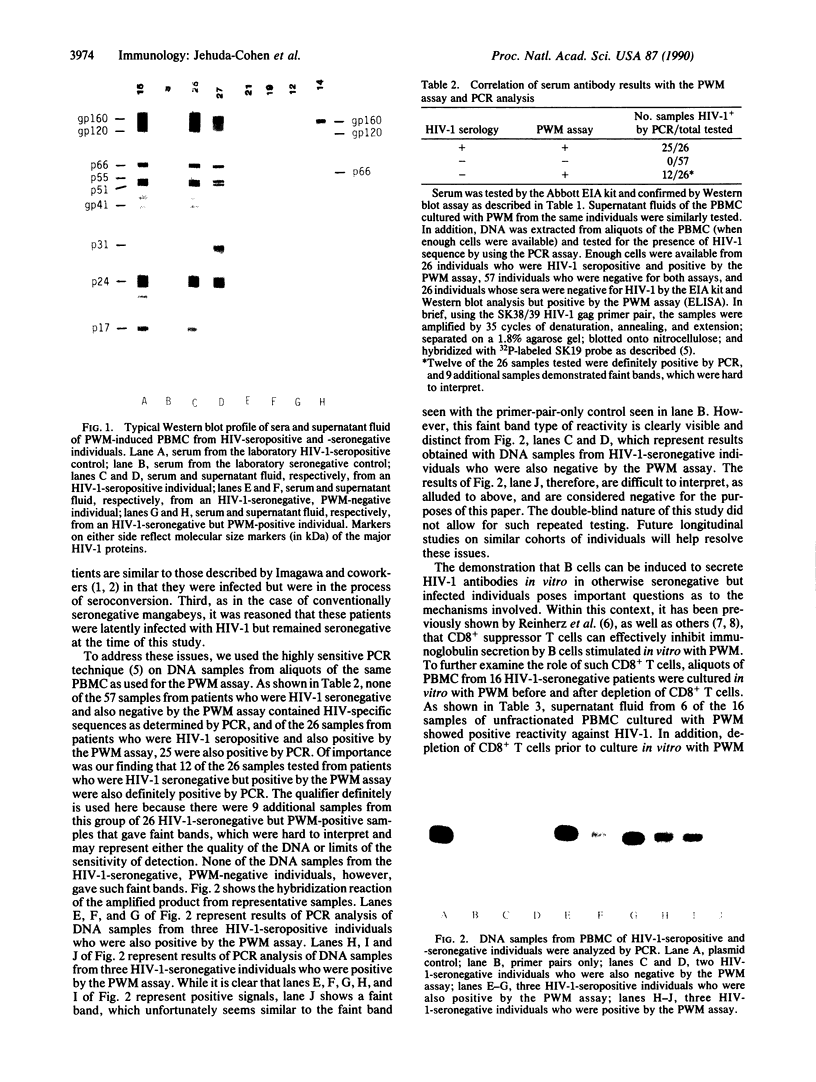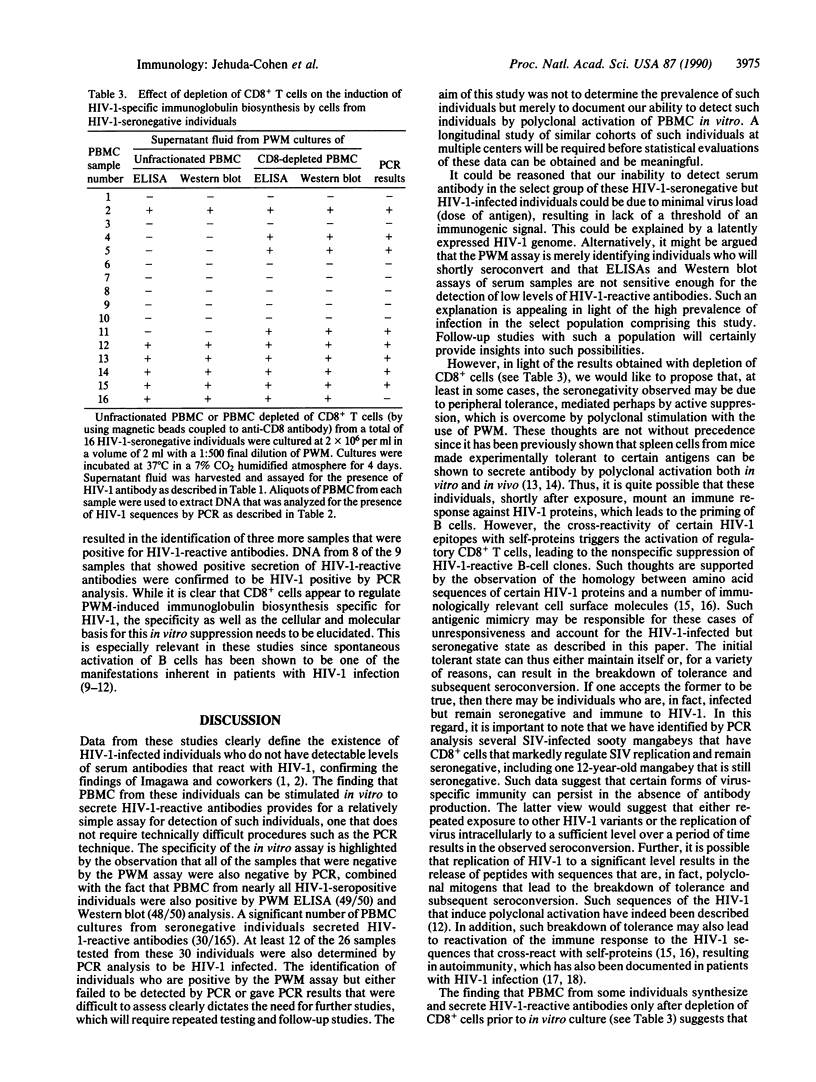Abstract
Identification of human immunodeficiency virus type 1 (HIV-1)-infected individuals is of paramount importance for the control of the spread of AIDS worldwide. Currently, the vast majority of screening centers throughout the world rely on serological techniques. As such, clinically asymptomatic but HIV-infected, seronegative individuals are rarely identified. In this report we show that 18% (30/165) of seronegative individuals who were considered to be a unique cohort of patients at high risk for HIV infection had circulating B cells that, upon in vitro polyclonal activation with pokeweed mitogen, produced antibodies reactive with HIV. Furthermore, polymerase chain reaction analysis of DNA obtained from aliquots of the peripheral blood mononuclear cells from these seronegative but pokeweed mitogen assay-positive individuals tested revealed the presence of HIV-specific sequences in a significant number of samples. In addition, depletion of CD8+ T cells from peripheral blood mononuclear cells of HIV-1-seronegative individuals prior to in vitro culture with pokeweed mitogen resulted in increased sensitivity for detecting HIV-reactive antibodies. This assay has obvious epidemiological implications, especially in the case of high-risk groups, and also provides a simple technique to enhance detection of HIV-infected individuals. Of further interest is the determination of the mechanisms related to the lack of HIV-specific antibodies in the serum of these infected individuals.
Full text
PDF




Images in this article
Selected References
These references are in PubMed. This may not be the complete list of references from this article.
- Amadori A., Zamarchi R., Ciminale V., Del Mistro A., Siervo S., Alberti A., Colombatti M., Chieco-Bianchi L. HIV-1-specific B cell activation. A major constituent of spontaneous B cell activation during HIV-1 infection. J Immunol. 1989 Oct 1;143(7):2146–2152. [PubMed] [Google Scholar]
- Ceuppens J. L., Meurs L., Baroja M. L., Van Wauwe J. P. Effect of T3 modulation on pokeweed mitogen-induced T cell activation: evidence for an alternative pathway of T cell activation. J Immunol. 1986 May 1;136(9):3346–3350. [PubMed] [Google Scholar]
- Dorsett B., Cronin W., Chuma V., Ioachim H. L. Anti-lymphocyte antibodies in patients with the acquired immune deficiency syndrome. Am J Med. 1985 Apr;78(4):621–626. doi: 10.1016/0002-9343(85)90405-x. [DOI] [PubMed] [Google Scholar]
- Edelman A. S., Zolla-Pazner S. AIDS: a syndrome of immune dysregulation, dysfunction, and deficiency. FASEB J. 1989 Jan;3(1):22–30. doi: 10.1096/fasebj.3.1.2562947. [DOI] [PubMed] [Google Scholar]
- Gartner S., Markovits P., Markovitz D. M., Kaplan M. H., Gallo R. C., Popovic M. The role of mononuclear phagocytes in HTLV-III/LAV infection. Science. 1986 Jul 11;233(4760):215–219. doi: 10.1126/science.3014648. [DOI] [PubMed] [Google Scholar]
- Golding H., Robey F. A., Gates F. T., 3rd, Linder W., Beining P. R., Hoffman T., Golding B. Identification of homologous regions in human immunodeficiency virus I gp41 and human MHC class II beta 1 domain. I. Monoclonal antibodies against the gp41-derived peptide and patients' sera react with native HLA class II antigens, suggesting a role for autoimmunity in the pathogenesis of acquired immune deficiency syndrome. J Exp Med. 1988 Mar 1;167(3):914–923. doi: 10.1084/jem.167.3.914. [DOI] [PMC free article] [PubMed] [Google Scholar]
- Hofmann B., Jakobsen K. D., Odum N., Dickmeiss E., Platz P., Ryder L. P., Pedersen C., Mathiesen L., Bygbjerg I. B., Faber V. HIV-induced immunodeficiency. Relatively preserved phytohemagglutinin as opposed to decreased pokeweed mitogen responses may be due to possibly preserved responses via CD2/phytohemagglutinin pathway. J Immunol. 1989 Mar 15;142(6):1874–1880. [PubMed] [Google Scholar]
- Hofmann B., Lindhardt B. O., Gerstoft J., Petersen C. S., Platz P., Ryder L. P., Odum N., Dickmeiss E., Nielsen P. B., Ullman S. Lymphocyte transformation response to pokeweed mitogen as a predictive marker for development of AIDS and AIDS related symptoms in homosexual men with HIV antibodies. Br Med J (Clin Res Ed) 1987 Aug 1;295(6593):293–296. doi: 10.1136/bmj.295.6593.293. [DOI] [PMC free article] [PubMed] [Google Scholar]
- Imagawa D. T., Lee M. H., Wolinsky S. M., Sano K., Morales F., Kwok S., Sninsky J. J., Nishanian P. G., Giorgi J., Fahey J. L. Human immunodeficiency virus type 1 infection in homosexual men who remain seronegative for prolonged periods. N Engl J Med. 1989 Jun 1;320(22):1458–1462. doi: 10.1056/NEJM198906013202205. [DOI] [PubMed] [Google Scholar]
- Koenig S., Gendelman H. E., Orenstein J. M., Dal Canto M. C., Pezeshkpour G. H., Yungbluth M., Janotta F., Aksamit A., Martin M. A., Fauci A. S. Detection of AIDS virus in macrophages in brain tissue from AIDS patients with encephalopathy. Science. 1986 Sep 5;233(4768):1089–1093. doi: 10.1126/science.3016903. [DOI] [PubMed] [Google Scholar]
- Kopelman R. G., Zolla-Pazner S. Association of human immunodeficiency virus infection and autoimmune phenomena. Am J Med. 1988 Jan;84(1):82–88. doi: 10.1016/0002-9343(88)90012-5. [DOI] [PubMed] [Google Scholar]
- Linton PJ L., Decker D. J., Klinman N. R. Primary antibody-forming cells and secondary B cells are generated from separate precursor cell subpopulations. Cell. 1989 Dec 22;59(6):1049–1059. doi: 10.1016/0092-8674(89)90761-7. [DOI] [PubMed] [Google Scholar]
- Loche M., Mach B. Identification of HIV-infected seronegative individuals by a direct diagnostic test based on hybridisation to amplified viral DNA. Lancet. 1988 Aug 20;2(8608):418–421. doi: 10.1016/s0140-6736(88)90412-6. [DOI] [PubMed] [Google Scholar]
- Mizuma H., Litwin S., Zolla-Pazner S. B-cell activation in HIV infection: relationship of spontaneous immunoglobulin secretion to various immunological parameters. Clin Exp Immunol. 1988 Mar;71(3):410–416. [PMC free article] [PubMed] [Google Scholar]
- Möller G., Gronowicz E., Persson U., Coutinho A., Möller E., Hammarström L., Smith E. Spleen cells from animals tolerant to a thymus-dependent antigen can be activated by lipopolysaccharide to synthesize antibodies against the tolerogen. J Exp Med. 1976 Jun 1;143(6):1429–1438. doi: 10.1084/jem.143.6.1429. [DOI] [PMC free article] [PubMed] [Google Scholar]
- Nossal G. J., Karvelas M. Soluble antigen abrogates the appearance of anti-protein IgG1-forming cell precursors during primary immunization. Proc Natl Acad Sci U S A. 1990 Feb;87(4):1615–1619. doi: 10.1073/pnas.87.4.1615. [DOI] [PMC free article] [PubMed] [Google Scholar]
- Nossal G. J., Pike B. L. Mechanisms of clonal abortion tolerogenesis. I. Response of immature hapten-specific B lymphocytes. J Exp Med. 1978 Nov 1;148(5):1161–1170. doi: 10.1084/jem.148.5.1161. [DOI] [PMC free article] [PubMed] [Google Scholar]
- Ou C. Y., Kwok S., Mitchell S. W., Mack D. H., Sninsky J. J., Krebs J. W., Feorino P., Warfield D., Schochetman G. DNA amplification for direct detection of HIV-1 in DNA of peripheral blood mononuclear cells. Science. 1988 Jan 15;239(4837):295–297. doi: 10.1126/science.3336784. [DOI] [PubMed] [Google Scholar]
- Pahwa S., Pahwa R., Saxinger C., Gallo R. C., Good R. A. Influence of the human T-lymphotropic virus/lymphadenopathy-associated virus on functions of human lymphocytes: evidence for immunosuppressive effects and polyclonal B-cell activation by banded viral preparations. Proc Natl Acad Sci U S A. 1985 Dec;82(23):8198–8202. doi: 10.1073/pnas.82.23.8198. [DOI] [PMC free article] [PubMed] [Google Scholar]
- Rosenkoetter M., Reder A. T., Oger J. J., Antel J. P. T cell regulation of polyclonally induced immunoglobulin secretion in humans. J Immunol. 1984 Apr;132(4):1779–1783. [PubMed] [Google Scholar]
- Saito S., Ando Y., Furuki K., Kakimoto K., Tanigawa T., Moriyama I., Ichijo M., Nakamura M., Ohtani K., Sugamura K. Detection of HTLV-I genome in seronegative infants born to HTLV-I seropositive mothers by polymerase chain reaction. Jpn J Cancer Res. 1989 Sep;80(9):808–812. doi: 10.1111/j.1349-7006.1989.tb01718.x. [DOI] [PMC free article] [PubMed] [Google Scholar]
- Schnittman S. M., Lane H. C., Higgins S. E., Folks T., Fauci A. S. Direct polyclonal activation of human B lymphocytes by the acquired immune deficiency syndrome virus. Science. 1986 Sep 5;233(4768):1084–1086. doi: 10.1126/science.3016902. [DOI] [PubMed] [Google Scholar]
- Thomas Y., Sosman J., Irigoyen O., Friedman S. M., Kung P. C., Goldstein G., Chess L. Functional analysis of human T cell subsets defined by monoclonal antibodies. I. Collaborative T-T interactions in the immunoregulation of B cell differentiation. J Immunol. 1980 Dec;125(6):2402–2408. [PubMed] [Google Scholar]
- Wolinsky S. M., Rinaldo C. R., Kwok S., Sninsky J. J., Gupta P., Imagawa D., Farzadegan H., Jacobson L. P., Grovit K. S., Lee M. H. Human immunodeficiency virus type 1 (HIV-1) infection a median of 18 months before a diagnostic western blot. Evidence from a cohort of homosexual men. Ann Intern Med. 1989 Dec 15;111(12):961–972. doi: 10.7326/0003-4819-111-12-961. [DOI] [PubMed] [Google Scholar]
- Young J. A. HIV and HLA similarity. Nature. 1988 May 19;333(6170):215–215. doi: 10.1038/333215c0. [DOI] [PubMed] [Google Scholar]




